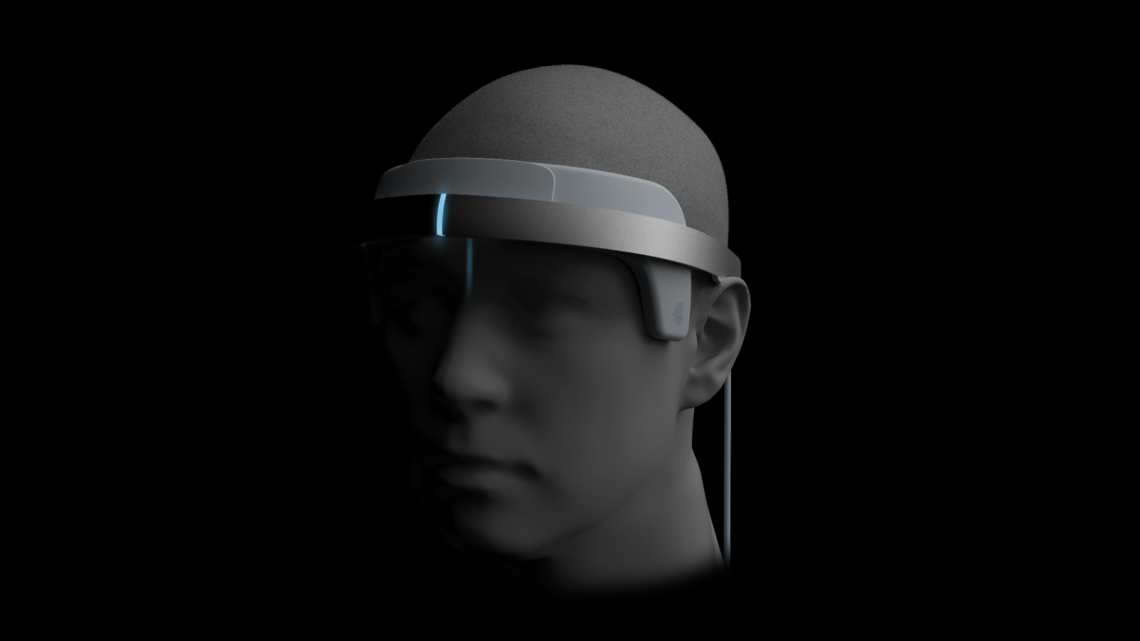May Lou Jepsen disrupts industries, especially when there is a chance to make technology affordable for all.
She and MIT Media Lab cofounder Nicholas Negroponte launched One Laptop Per Child, a non-profit that made and sold inexpensive laptops targeted at children in developing countries. Negroponte developed the business model, selling $100 laptops in bulk to schools around the world, while Jepsen engineered and built the machines. At the time laptops sold by incumbents were priced at thousands of dollars –putting them out of the reach of most people.
Now Jepsen, a PhD who has led projects at Intel, Google, Facebook, and Oculus and earned 250 patents, launched 50 products and generated billions in revenue by leveraging consumer electronics’ trillion-dollar supply chain, is out to do the same in healthcare. Most of the world’s population can’t have their diseases adequately diagnosed or treated; their depression understood. Jepsen’s California-based company Openwater wants to replace the costly approaches of today’s world with non-invasive tools, based on lasers and ultrasound and consumer electronics. For example, with a wearable head visor that could cost the same as a smart phone. (see the image)
Openwater’s scaleable, wearable tech has the potential to not only democratize life- saving body scans but also introduce new types of non-invasive medical interventions. The technology-is already in clinical trials with Penn Medicine, the University of Pennsylvania’s academic medical center, Brown School of Medicine, Terasaki Institute, Hartford Healthcare and The University of Arizona.
If the technology achieves its potential it could revolutionize the way strokes, cancers and mental disease are diagnosed and treated, drastically improving healthcare, and disrupting the revenues of industry players like Siemens, Philips and General Electric that sell MRI machines for $1 million to $3 million, as well as hospitals that charge a premium for the scans.
Jepsen’s novel approach to neuro diagnostics and brain therapeutics was developed using her expertise in holograms, consumer electronics manufacturing, and VR and AR displays. She says she is used to being laughed at and underestimated. But it’s not incumbents who make exponential leaps, says Jepsen. It takes an outsider.
Her interdisciplinary approach and use of advances in everything from Moore’s Law to Light Detection and Ranging (LiDAR ) technology, silicon-based ultrasonics, high-resolution camera chips, and AI for data interpretation to disrupt yet another entrenched industry contains valuable lessons in how to innovate for impact.
Developing An EKG For Your Forehead
Jepsen has personal reasons for reducing the cost of body scans. She would have died while studying for her PhD at Brown had a professor not paid for the MRI scan she could not afford. It turns out she’d had a brain tumor for 17 years and it was slowly killing her. After surgery and starting a regimen of medications she must take for life to keep the tumor from returning, she finished her PhD., then co-founded her first company, MicroDisplay, which helped pioneer tiny silicon chips with liquid crystals for the first commercial projectors on the market, the same technology now found in VR and AR displays. Next, she joined Intel to head its display division and then worked as a professor at MIT’s Media Lab. She co-founded One Laptop Per Child while at MIT and then left to launch a third startup, Pixel Qi, a Taiwan-based maker of inexpensive low-power display laptops and tablets. The company ran into headwinds when the 2008 economic crisis hit. Then, she joined Google’s X team to work on moonshots and later took on roles as the executive director of engineering at Facebook and the head of display tech at its Oculus virtual reality arm.
But Jepsen said she wanted to work on tech for good that would have a real impact and realized that she could use experience gained early in her career in holograms, her consumer tech manufacturing know-how and advances in infrared lasers, camera and display chips, and apply all of it to healthcare. So, five years ago, she launched Openwater.
“Healthcare is broken, so I zeroed in on an imaging tech that saved my life,” says Jepsen. ” I was lucky I almost didn’t get the scan due to the high cost and 28 years later 75% of humanity still lacks access to MRIs.”
Openwater’s innovations take advantage of the fact that Moore’s Law now enables phase modulation of light and sound with consumer electronics. The startups’ technology works by using silicon to modulate the phase of light and sound when they penetrate the body and records a phase wave hologram of the interference. The camera “sees” changes in the inference patterns, frequencies. and contrast.
“We use math to find where the light has been, just like a sailor reads waves on the oceans to spot where the fish are,” says Jepsen. In Openwater’s case the waves are represented by wavelength sized pixels. “If we look at these patterns in math, we can see all kinds of different things. When the light hits moving blood cells it ricochets, then we can even see your heart pushing your blood up to your brain,” she says.
Strokes occur when blood is blocked in one of three large vessels in the brain. “When one of these is blocked the whole branch of the tree dies unless the patient has a thrombectomy to pull out the clot,” says Jepsen. “It’s a plumbing problem.” “
Strokes are the number two killer globally. Some 90% of patients could fully recover with no neural deficit if they were treated within two hours of a stroke’s occurrence. The trouble is that first responders have no way of knowing if a person has had a stroke and need to rule out a lot of other factors, losing precious time. “
Openwater’s technology can pinpoint with precision where blood to the brain is flowing and where it is not, giving first responders an immediate and accurate way of determining whether a patient has suffered a stroke. “It is like having an EKG on your forehead,” says Jepsen.
Human studies ongoing at Penn Medicine compared Openwater’s data to data from CT, MRI, and other types of scans. The startup’s technology “has excellent specificity and sensitivity, says Jepsen. In its own lab’s tests in 2019 the technology performed 200x better in detecting blood flow than an ultrasound, MRI or CT, prompting Jepsen to decide that Openwater’s first product will target strokes.
The idea is to make Openwater’s visor-like device – which Jepsen thinks could be made at the price of a smartphone once production scales -widely available the same way that defibrillators are installed in public places to treat people who have heart attacks or even the way that smart watches now can sense blood pulse rates.
Ambulances could be equipped with the device. Openwater envisions an interface that would sound an alarm when a severe large vessel occlusion stroke is apparent and then map a route to the closest appropriate hospital and inform the doctor who would perform the thrombectomy that the patient is on their way because every minute counts for a stroke.
The company may give away the devices for free and charge for processing and analyzing the data, she says.
But Openwater’s technology promises to be able to do more than diagnostics. It could also deliver therapeutic treatment because the technology can’t only record but also steer the beams. In tests on mice the wearable visor was able to treat glioblastoma, the most aggressive type of brain cancer, by steering sound waves to kill the cancer cells. Openwater uses ultrasound harmonic resonance frequency on cancer cells in the same way that an opera singer uses sound to burst a glass without harming anything else in the room. In the case of glioblastoma, the ultrasound harmonic resonance frequency causes the cells to expand and contract and eventually burst, killing 97% of the cancer cells in mice, a result that is five times better than chemotherapy, Jepsen says. The startup hopes to begin trials in humans within a year.
Harmonic resonance ultrasound can also be used to change neuron firing patterns and/or neuron-synapse growth, says Jepsen, meaning the technology has the potential to be used to treat depression, anxiety, obsessive compulsive disorder (OCD), substance abuse, addiction, post-traumatic stress disorder (PTSD) and neurodegenerative and cognitive disorders.
Nearly every family has been touched by stroke, cognitive disorders like Alzheimer’s, mental disease like depression and cancer, says Jepsen, so the technology could have a huge impact, she says.
There are also indications that the technology could shine a light on other diseases by generating unprecedented image quality of the kidneys, abdomen, and brain.
Going To Market
The startup’s proprietary phased wave technologies and its underlying hardware and software innovations have 60 patents (issued or in process), Its first product, which is aimed at large vessel occlusion patients has been in human trials for over a year at Penn Medicine and Brown University medical centers. The company is now scaling up trials to get more patient data and expects FDA approval next year. Jepsen expects the process to go smoothly. Developing a pharmaceutical drug takes $2.6 billion and 12 years. Achieving FDA approval for therapeutic hardware is cheap and fast in comparison, she says.
If Jepsen had her way things would move even faster because the objective is not just democratizing healthcare but saving lives. Some 55% of severe stroke victims die or live with major disability. Openwater believes its diagnostics could lower that figure to 10%.
Openwater’s invention could put a big dent in the MRI market – which is projected to grow to 12.9 billion by 2030 and impact the revenues of hospitals which reap a large part of their margins from imagining.
But just as One Laptop Per Child didn’t set out to fight Intel or Microsoft Openwater’s goal is not to destroy the business of the makers of MRI machines, says Jepsen. The goal is to bring better healthcare to more people.
“We learned a lot of lessons [with One Laptop Per Child] trying to do this in education,” says Jepsen,.“ It catalyzed $30 billion of revenue and touched millions of children but our ambitions were ever larger,” she says. “Just as no one in the computer industry would say they do not want to improve education. no one in healthcare is opposed to helping stroke victims or curing cancer or neurodegenerative disease,” Jepsen says. “The question is how fast can they do it?”
She is betting Openwater will get there first. “I predict millions of lives saved in just a few years,” she says. “I believe the old top-down approach to medical device innovation is broken, just as it was in computers.” PCs sell in tens of millions; smartphones by the billion. Mainframe computers sell by the thousand. “MRI machines are like that: there are fewer than 50,000 in operation worldwide, each costing millions of dollars,” says Jepsen. “That’s mad. The question is, can we learn from consumer electronics, and do the best work in high volume, for the whole world, rather than via specialized machines, accessible only for the rich few?”
This article is content that would normally only be available to subscribers. Sign up for a four-week free trial to see what you have been missing.







